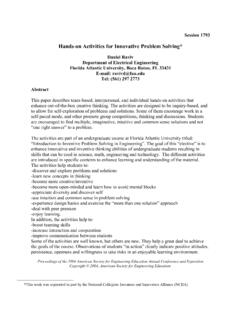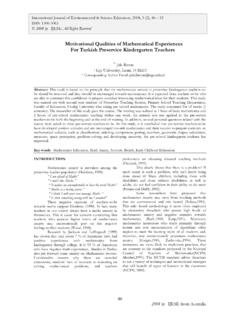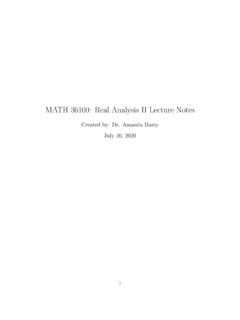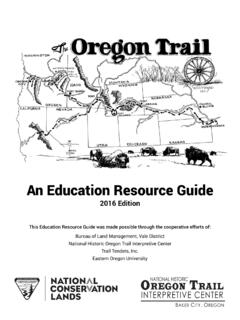Transcription of Theories of Intelligence - ed
1 Theories of Intelligence , Learning, and Motivation as a Basis for Praxis Dr Eulalee Nderu-Boddington Education Assistant Professor at Prince Sultan University Riyadh Saudi Arabia May 26th 2008. ABSTRACT. This paper examines how Piaget, Werner, and Gardner differ regarding the roles of cognition, Intelligence , and learning in the developmental process. Piaget believes in the predominance of genetic factors. Werner stresses the influence of biological factors, while Gardner proposes that the environment plays a greater influence in how Intelligence and learning are acquired. This paper also surveys research on achievement and learning strategies and their role in student motivation. The development of conceptual understanding is related to prior knowledge, interest, learning goals, and achievement goals. Introduction This paper focuses on the developmental Theories of Werner, Gardner, and Piaget, all of whom have significantly influenced the field of education through their differing understandings of how students learn from childhood to adulthood.
2 Most researchers agree that a combination of biology and environment affects personality and Intelligence , but they differ in assigning relative importance to these two influences. Although poor nutrition, poor health care, and head injuries have been linked to poor IQ scores, for the most part environmental variables have not been found to account for a substantial portion of observed variations in human Intelligence . Therefore, some psychologists believe heredity is the dominant influence on Intelligence . They base their views on research that concentrates on variations among people in general cognitive ability or IQ. Others believe that such research overemphasizes the concept of IQ and gives too much credit to genetics (Azar, 1995). Dr. Thomas Bouchard, a researcher on Intelligence from the University Of Minnesota Center for Twins and Adoption Research, claims that when individuals are under reasonably good circumstances much of the variation in IQ among them is genetic (quoted in Azar, 1995, p.)
3 27). Most other research has concluded that 40% to 80% of differences in IQ score are due to inheritance. The higher estimate comes from large studies of identical twins who share all the same genes; truly inherited genes should correlate perfectly. Any trait due to environment should have no more than chance correlation (Azar, 1995). A controversial exposition of the implications of a genetic view of Intelligence was developed by Murry and Hernstein (1994). The Bell Curve stated that individuals differ substantially in their cognitive abilities, that these differences are inherited as much as acquired, and that Intelligence is distributed in the population along a normal distribution curve. That much of their analysis was noncontroversial. However, Murry and Hernstein went on to observe that different races perform differently on IQ testing and to conclude that different racial groups have different cognitive abilities.
4 In America, Asians score on average slightly above the norm and Blacks below average. This impermeable caste system has been widely debated. Liberals have denounced Murry and Hernstein as racist, while some conservatives have found in their analysis a convenient critique of such social programs as affirmative action. Over the years there has been no single way of defining and measuring Intelligence . As Morgan (1996) has noted, Thurstone was the first theorist to suggest that the human organism is too complex for intellectual activity to be determined only by a single human factor. Thurstone described what he called primary mental abilities and introduced Intelligence testing to measure intellectual functioning. He developed six different types of test for three age levels, each designed to measure different abilities.
5 Thurstone's theory suggested that Intelligence cannot be determined by measuring a single ability; rather, multiple abilities must be considered. Assessing these abilities such as verbal ability, deductive reasoning, spatial ability, and perceptual speed is essential to a unified theory of Intelligence , Thurstone believed. The practice of Intelligence testing on children today still incorporates Thurstone's theory of multifactor analyses (Morgan, 1996). The Stanford Binet IQ test, first published in 1916, provides a single score that reflects general Intelligence . The Wechsler Intelligence Scale for Children Revised (WISC-R), another instrument used to test IQ, was designed for children age 6-16 and consists of 12 subtests. Half of the test is verbal and the other half nonverbal. This test is commonly used today to test children for placement in classes for the gifted and talented.
6 The two tests are sometimes used together (Morgan, 1996). IQ tests continue to be controversial. Estimates of the heritability of Intelligence range from 40% to 80%. Some experts claim that children can raise their IQ while others assert that it is stable. Some argue that written IQ tests should be supplemented by personal interviews. Psychometrictrists have argued that IQ testing should be replaced by physical tests to measure reaction speed, glucose production in the brain, the speed of neural transmission, and even the size of the brain (Azar, 1995). Some psychometrictrists who study how children learn advocate that children's potential be examined by using indicators of Intelligence that do not depend on prelearned solutions to problems. For example, the Torrance Test of Creative Thinking is a figural and verbal assessment that evaluates children's responses to open -ended problem-solving situations.
7 That test attempts to measure not only manipulation of familiar concepts but also the ability to deal with unfamiliar concepts (Fraiser, 1989). According to Fraiser (1989), a continuing outmoded emphasis on IQ testing is based on limited criteria, and minority and poor students do not fare well under such conditions. Therefore, a more complete definition of Intelligence would be part of the solution to eliminate barriers. A growing dissatisfaction with traditional Intelligence tests has led some information processing theorists to examine other approaches and to create a receptive scientific environment for imaginative and inventive constructs (Sternberg, 1985). As Powell and Gallagher (1993) have noted, one theorist with a more complex understanding of Intelligence was Perkins, who argued for three different kinds of Intelligence .
8 1. Neural Intelligence refers to the speed and precision of information processing in the neural system. 2. Experiential Intelligence is knowledge gained through extended lived experiences, both in academic areas such as physics and nonacademic areas such raising a family. 3. Reflective Intelligence means thinking strategies, metacognitive awareness, and managing one's own thought processes. Neural Intelligence is largely given, but experiential and reflective Intelligence may be increased with educational interventions. According to this view, teachers can help students improve their Intelligence by enlarging on the experimental domain and by helping students learn to be more reflective and to use more of their metacognitive capabilities than they have done previously (Powell & Gallagher, 1993). Gardner's Theory of Multiple Intelligences Perhaps the most well-known theorist to propose a theory of multiple intelligences is Gardner (1983).
9 While some practitioners still use Thurstone's methods, Gardner's theory offers a different way to assess learners' intellectual functioning. Gardner argued that people have a plurality or set of intelligences or abilities rather than a single Intelligence . Gardner's theory proposes seven distinct units of mental functioning, each of which can be observed and measured. As Oliver (1997) notes , different cognitive styles have been observed by other theorists. What makes Gardner's approach different is that each factor of cognition constitutes a separate construct that would qualify as Intelligence . One question critics have asked, then, is whether Gardner has actually distinguished multiple intelligences or simply cognitive styles. Merssick (1976) defined cognitive style as a perceptual preference: Each individual has a preferred way of organizing all that he sees and remembers and thinks about.
10 Consistent individual differences in these ways of organizing and processing information and experiences have come to be called cognitive styles. These styles represent consistencies in the manner or form of cognition, as distinct from the content of cognition or the level of skill displayed in the cognitive performance. They are conceptualized as stable attitudes, preferences or habitual strategies determining a person's typical modes of perceiving, remembering, thinking and problem solving. As such, their influences extend to almost all human activities that implicate cognition, including social and interpersonal functioning. (pp. 4-5). Oliver (1997) has noted that Gardner's multiple Intelligence theory can be compared with cognitive style. He states that investigators in intellectually related fields have identified intellectual functioning (cognition) as central to Theories of personality.

















